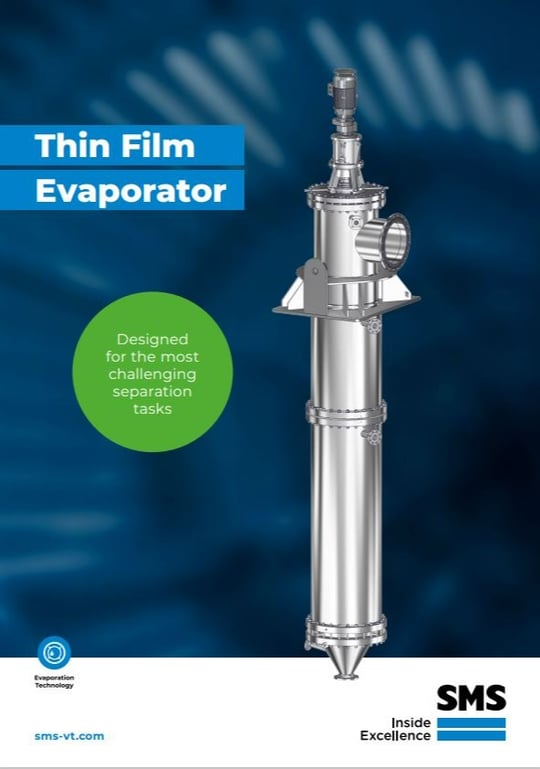
Thin Film
Evaporator
Perfectly adapted to the multitude of separation tasks
Thin Film
Evaporator
Perfectly adapted to the multitude of separation tasks
The evaporator for demanding applications
SMS combines more than 60 years of experience in manufacturing and application of thin film evaporators of the companies Luwa, Samesreuther and Canzler. Thin film evaporators are available in an unchallenged variety of different rotor designs, horizontal or vertical orientation as well as cylindrical and conical shape for co-current and counter-current vapour flow. Therefore, they are perfectly adapted to a multitude of separation tasks.
Advantages
Special characteristics of thin film evaporators compared to other evaporator types are:
- the reliable continuous processing of viscous, fouling and soiled liquids
- gentle treatment due to a short residence time and a narrow residence time distribution
- the evaporation performance and
- the low hold-up with minimal losses in case of product changes
in a wide range of pressures, temperatures, viscosities and evaporation performances. These advantages explain why thin film evaporators are the best choice for a large range of applications, especially for the treatment of mixtures that are difficult to handle.
Working principle
For the thermal separation of a mixture a thin film is produced at the heated wall of a cylindrical or conical evaporator. A distribution ring on the rotor distributes the liquid evenly across the periphery. Then, the blades fitted at the rotor spread the liquid as a thin film of min. 0.5 mm over the heat transfer surface.
The model concept for the flow within the thin film evaporator assumes that prior to each rotor blade a bow wave is formed. In the gap between the rotor blade and the heating surface, fluid is supplied from the bow wave, a highly turbulent area with intense heat and mass transport. This results in a good heat transfer performance even with viscous products. In addition, the formation of deposits is avoided and the intensive mixing also protects temperature-sensitive products from overheating.
Another important task of the rotor is to stabilise the liquid film on the heating surface at high evaporation rates. This allows evaporation in the area of nucleate boiling without film rupture. At the same time the liquid film is pressed against the heating surface by the centrifugal force. This avoids the adverse evaporation mode, in which a vapour layer with insulating effect is formed under the liquid film. Due to this operating principle extremely high specific evaporation rates are achievable in thin film evaporators.
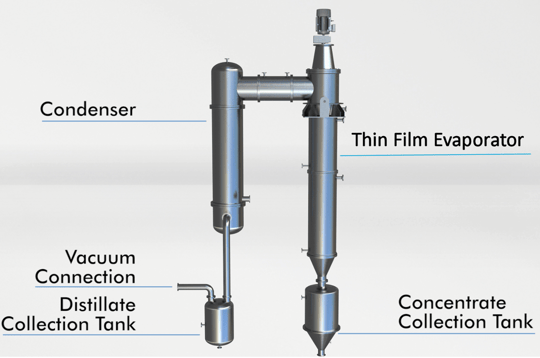
Thin film evaporation system
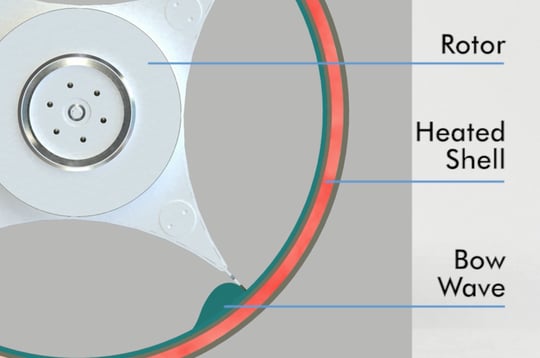
Cross section of thin film evaporator
Vertical design of a thin film evaporator - operating principle
Horizontal design of a thin film evaporator - operating principle
Get your free copy!
We are number 1 in thin film evaporation technology. Find out more about our thin film evaporators in our flyer:
Types of thin film evaporators
Thin film evaporators are designed in vertical and horizontal orientation with cylindrical and conical heating jackets. In vertical evaporators, the product which has to be processed is fed at the upper end of the apparatus. Depending on the application the volatile components evaporate and are discharged at the upper or the lower end of the evaporator. Entrained droplets or foam are removed from the vapour before the vapour is fed to further process steps.
Typical thin film evaporator designs are the cylindrical body design DVN („LUWA“) and DVB („SAMBAY“) with vertical orientation, as well as the conical body design DKV („SAKO“® KV) with vertical orientation and DKH („SAKO“® KH) with horizontal orientation. SMS installs rigid blade rotors in the DVN and in the conical thin film evaporators, which are suitable for products with viscosities up to 70,000 mPas. Due to the closed design this kind of rotor is particularly easy to clean. By the adjustment of the rigid blade rotor in axial direction, it is possible to adjust the gap width and thus the film thickness in the conical evaporators. This can be the decisive advantage for degassing applications where the low-boiling components have to be reduced to a minimum.
In the thin film evaporators type DVB, rotors are equipped with hinged wiper blades that can be optimally adapted to the task. The centrifugal force presses the wiper blades to the heating surface so that high evaporation ratios can be achieved at low flow rates. The hinged wiper blade types of evaporators are particularly suitable for products with fouling tendency.
For other applications such as the separation of monomers from pre-polymers and polymers, vertical thin film evaporators type DVF with spring wiper elements and DVS with Smith-Rotor are available. The specially designed wiper elements made of PTFE or graphite are partially spring-loaded and support the liquid in the film.
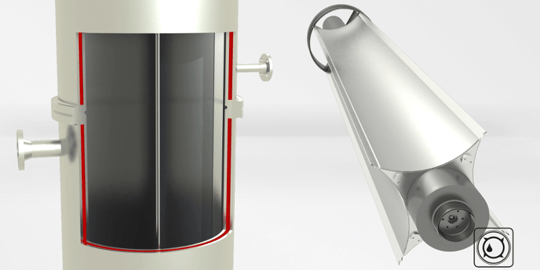
Rigid blade rotor

Rotor with metal wipers
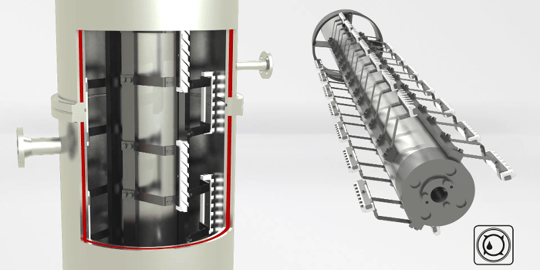
Rotor with spring-loaded wipers

Conical rigid blade rotor
Typical Applications
SMS has supplied more than 6,000 thin film evaporators to more than 50 countries.
Applications:
- Distillation, separation, concentration, stripping, deodorisation, degassing, reaction
- Heat-sensitive, viscous, fouling and foaming products
- Continuous processing
